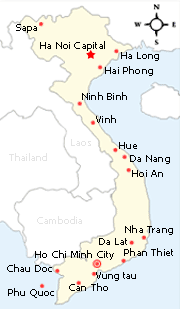|
Heroes of the underground The extraordinary mazes on many levels total more than 200 kilometers in length and are full of nooks and crannies where freedom fighters and their civilian supporters lived, ate, stored food and weapons, cared for the sick and wounded, planned strategy and tactics, and fought the enemy.
Nguyen Tu, who works there, describes the multi-layered cobweb as a unique wonder of combat, a glorious symbol of the Vietnamese people’s heroism. The guerrilla fighters used the tunnels to conceal themselves from the enemy and launch surprise attacks seemingly out of nowhere, as well as to communicate and store arms and provisions. When American soldiers stepped into Cu Chi land for the first time, they would cry out “Underground village!”, “Danger zone!” or “Can’t see any Viet Cong yet they are everywhere!” They used the term "black echo" to describe the conditions within the tunnels, where fresh air, food and water were scarce but ants, spiders, mosquitoes and poisonous centipedes were not. A camouflaged trap door opens A visitor gets out of the camouflaged trap door A tourist fires an assault rifle at the shooting range Some tunnels have been enlarged to accommodate western visitors, and dim lights have been installed here and there to make the going easier Vestiges of bombs on display at the Cu Chi Tunnels site The guerrillas usually spent the daytime in the tunnels working or resting and only came out at night to scavenge for supplies, tend their crops or engage the enemy in battle. Sometimes, during periods of heavy bombing or American troop movement, the guerillas stayed underground for many days at a time. Illness was rampant among the tunnel dwellers, especially malaria, which caused more deaths than anything except battle wounds. Yet in spite of the hardship, the guerillas waged successful campaigns against a partly conscripted army that was technologically far superior, and eventually wore down their enemy. Today there are 121 kilometers of preserved tunnels at Cu Chi. They form a war memorial and a sort of school to educate visiting Vietnamese and foreign politicians, army officers, businessmen, students and indeed anyone with an interest in Vietnam’s struggle for independence. Millions of people from around the world have visited the Cu Chi Tunnels, among them Cuban former President Fidel Castro, Japan’s former Prime Minister Junichiro Koizumi, one of the Rockefeller billionaires, and politicians from Australia, France, Sweden and Russia. But they can’t upstage the real VIPs of Cu Chi. “You only need to crawl into the tunnel a few yards to understand how this tiny country could defeat the US, how this barren and poor land of Cu Chi could fight the good fight for decades,” says Tran Nguyen Minh, a HCMC tour guide with 20 travelers from France in tow. Thanks to the incredible system of tunnels, fortifications and combat trenches, the soldiers and civilians of Cu Chi District made a huge contribution toward their country’s reunification. Some tunnels have been enlarged to accommodate western visitors, dim lights have been installed here and there to make the going easier, and the booby traps have been clearly marked. Underground conference rooms where campaigns such as the 1968 Tet Offensive were planned have been restored, and visitors can now dine on the simple meals of Vietnam’s erstwhile freedom fighters. There are quite a few amusements above ground too, like the shooting range where visitors can fire an assault rifle. But Cu Chi is about the tunnels and the extraordinary people they housed. “It’s unbelievable!” exclaims Stephane Thomas from France as he climbs out of a manhole in the jungle floor. “Once it’s closed and camouflaged, it is almost undetectable,” Stephane declares. Most of Vietnam’s senior politicians have visited the tunnels. There’s an official Cu Chi website where current Party Chief Nong Duc Manh hails the underground maze as “an exploit of supreme intelligence.” There’s still much work to be done, like restoring the abandoned jeeps, tanks, bulldozers, crashed helicopters, artillery and unexploded bombs that still litter the landscape, and putting them on display (after the bombs have been rendered harmless, of course). An old saying has it that “Forests also feel resentment, mountains also feel hate”, which is why the damage to the land and trees of Cu Chi is being gradually repaired. It’s quite a job as the area was pounded by countless bombs and sprayed with by toxic chemicals. Today in Cu Chi, the tunnel dwellers of yore tell visitors about their underground lives and experiences, how they dug and fortified the tunnels, and how they beat G.I. Joe. Since 1990, the number of visitors has swelled to more than one million a year. They come out of curiosity and a desire to learn about the tunnels and the strong-willed people of Cu Chi and discover how they overcame massive opposition and cruelty. In the words of Cu Chi Tunnels director Tran Van Tam, the tunnels are “an integral part of the Vietnamese people’s heroic struggle, a legend of the twentieth century.” An illustration of the Cu Chi Tunnels complex Reported by Ha Anh - Thanhniennews Other news for Tuesday 23 June, 2009
View all news for Tuesday 23 June, 2009 on one page News for Thursday 18 June, 2009 View all news for Thursday 18 June, 2009 on one page Recent News
|















